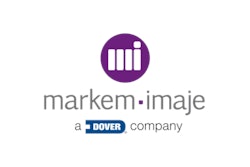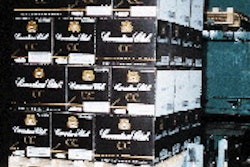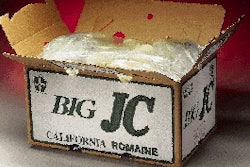Two new bar-code printer/applicators permit Dutch Gold Honey to meet dual-panel case labeling requirements while saving about $5ꯠ per year in material costs compared to traditional corner-wrap labelers that use larger wraparound labels. Dutch Gold's labels, which measure 4"x4", are applied to two adjacent sides of a case, eliminating the label material that typically wraps around the corner.
The Lancaster, PA-based honey processor installed the two Cimjet printer/applicators from Markem (Keene, NH) on two packaging lines in August '97. The labelers are being used on lines that pack honey into a variety of plastic and glass containers for Dutch Gold brand and private-label retail accounts.
"Since most of our customers want adjacent-side bar codes, we looked at several corner-wrap labelers," says Chris Johns, plant manager. "We liked the savings offered by Markem with the separate labels versus the corner wrap."
Easier and fewer changeovers
The cost savings was only one factor in deciding on Markem, says Jim Gerlach, production manager: "We also liked this labeler because the label and printer ribbon came in a larger-capacity roll than was available with many of the others. That reduces the number of changeovers."
Labels come in 11"-outer-diameter rolls containing about 3꼀 labels. That's about 1겨 more than other suppliers that were considered, according to Gerlach. The thermal-transfer ribbon comes in rolls of the same length so that both media always run out simultaneously, further reducing the number of changeovers required.
Threading in a new roll of labels or ribbon is easy, says Gerlach. "You don't have to weave the material in and out of a lot of different guides or lift any guards. There are two guide posts for the ribbon and maybe three for the label. And they're slotted so that you don't have to try to force the material in and out. You can just come down from the top." Material changeovers take just five minutes, says Gerlach.
Changing from one label format to another is also fast. All label formats are stored right in the printer/applicator itself. Operators can select the proper format from a keypad and LCD screen on the unit. Dutch Gold designs new formats using Markem's label design software that runs on a separate laptop computer using Windows(TM) 95. New label formats are quickly downloaded from the laptop to the printer on the production floor. Label information includes a UPC bar code, product identification information, units per case and primary package size.
During the day of Packaging World's visit, Dutch Gold was labeling cases of its Dutch Gold honey in a 12-oz plastic bear-shaped package. The operation of the labeler is similar to a corner-wrap labeler. The process starts by printing two labels sequentially by the Markem print engine. The labels are immediately dispensed onto the vacuum grid of the applicator arm, which is angled like a boomerang. One label indexes out toward the edge of the arm where it flags, waiting to be applied to the end of the approaching case. The other label is staged at the very base of the arm on the same vacuum grid, well out of the way.
When the case reaches the applicator arm, the leading edge of the label is adhered to the end of the box and wiped on by a rubber blade at the very tip of the arm. The arm then slides off the end of the case and around the side. As this is happening, the second label advances to the end of the applicator arm, where it is adhered and wiped on by the same blade. When the case clears the arm, the arm swings back into its start position and two more labels are printed and dispensed onto the arm to await the next case.
No cost difference
Despite the application of two separate labels, Johns maintains that there was no significant difference in the cost of this applicator compared to a conventional corner-wrap labeler. Thus, the overall economics of buying and operating the machine are less than a corner-wrap labeler, he says. Other benefits are its small footprint and portability. "We bought it mounted on a conveyor of its own that rolls right into our line."
Finally, Johns liked the fact that the print engine itself was a Markem unit. "We felt it was more of an industrial-strength printer than some others we saw. That's one thing that attracted us very much; it wasn't just a printer that someone grabbed and made to fit the application."


























